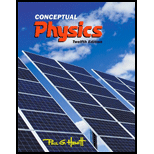
What is the role of “loose” electrons in heat conductors?
The role of loose electrons in heat conductors.
Answer to Problem 1RCQ
Solution:
Conduction is the phenomenon of transmission of heat by the collision of the particles and the movement of electrons within a body.
Explanation of Solution
Loose electrons are the moving electrons that carry energy from one part to another in the conductor to conduct electricity. Solids are made up of atoms that have one or more loose or free electrons that conduct electricity. Mostly, the metals have the loosest electrons, which are free to carry energy.
Conclusion:
Therefore, loose electrons help in the conduction of heat by transferring energy from one electron to the neighboring electrons.
Want to see more full solutions like this?
Chapter 16 Solutions
Conceptual Physics (12th Edition)
Additional Science Textbook Solutions
Applied Physics (11th Edition)
University Physics (14th Edition)
Physics: Principles with Applications
Essential University Physics: Volume 1 (3rd Edition)
Conceptual Physical Science (6th Edition)
College Physics: A Strategic Approach (4th Edition)
- Why is a person able to remove a piece of dry aluminum foil from a hot oven with bare fingers, whereas a burn results if there is moisture on the foil?arrow_forwardWhy is heating more efficient in large apartment buildings than in single-family dwellings?arrow_forwardExplain why high quality thermos bottles have a vacuum lining as a major component of their insulating ability.arrow_forward
- In buildings that are being electrically heated, is it at all wasteful to turn all the lights on? Is turning all the lights on wasteful if the building is being cooled by air- conditioning?arrow_forwardwhen our bodies are hot they produce sweat, which helps to cool us down. Using this fact determine whether your skin or sweat has a higher conductivityarrow_forwardIf air is a bad conductor of heat, why do we not feel warm without clothes?arrow_forward
- Question 1 (a) State Coulomb's Law. What is unit of electric charge? (b) When a 390 g piece of iron at 200°C is placed in a 85 g copper calorimeter cup containing 230 g of glycerine at 15°C, the final temperature is observed to be 40°C. Estimate the specific heat of glycerine.( specific heat of iron 450 J/kg°C, Specific heat of copper 385 J/kg°C)arrow_forwardAn iron nail becomes hot when it is hammered, Why?arrow_forwardAn object radiating energy at night is in contact with relatively warm Earth. How does conductivity affect whether or not it becomes appreciably colder than air?arrow_forward
- Cups of water for coffee or tea can be warmed with a coil that is immersed in the water and raised to a high temperature by means of electricity. (a) Why do the instructions warn users not to operate the coils in the absence of water? (b) Can the immersion coil be used to warm up a cup of stew?arrow_forwardhow do you know if the material is a conductor/insulator?arrow_forwardWhy does a bicycle pump feel warm as you inflate your tire?arrow_forward
 Principles of Physics: A Calculus-Based TextPhysicsISBN:9781133104261Author:Raymond A. Serway, John W. JewettPublisher:Cengage Learning
Principles of Physics: A Calculus-Based TextPhysicsISBN:9781133104261Author:Raymond A. Serway, John W. JewettPublisher:Cengage Learning
